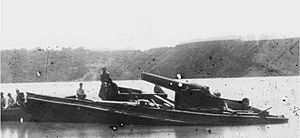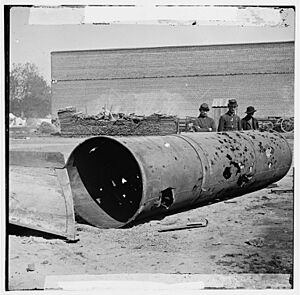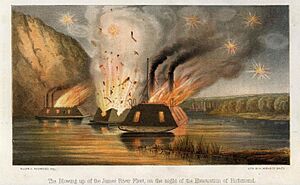Battle of Trent's Reach facts for kids
Quick facts for kids Battle of Trent's Reach |
|||||||
|---|---|---|---|---|---|---|---|
| Part of the American Civil War | |||||||
 A sketch by Alfred Waud dated February 11, 1865 from Harper's Illustrated showing the Confederate fleet breaking through the boom at Trent's Reach. |
|||||||
|
|||||||
| Belligerents | |||||||
| Commanders and leaders | |||||||
| Strength | |||||||
| Land: ~30 artillery pieces 1 fort 4 shore batteries River: 1 monitor 2 gunboats 1 torpedo boat 1 torpedo launch |
Land: ~16 artillery pieces 2 shore batteries River: 3 ironclads 5 gunboats 3 torpedo boats |
||||||
| Casualties and losses | |||||||
| 3 killed ~40 wounded 1 monitor damaged 1 gunboat damaged 1 fort damaged |
4-10 killed 15 wounded 1 gunboat sunk 1 torpedo boat sunk 3 ironclads damaged 3 gunboats damaged 1 torpedo boat damaged |
||||||
The Battle of Trent's Reach was one of the last big naval battles of the American Civil War. It happened from January 23 to 25, 1865. A strong group of Confederate warships tried to break through a blockade on the James River. Their goal was to attack City Point, which was a major supply base for General Ulysses S. Grant's Union Army. Grant was trying to capture Petersburg, Virginia, at the time. After two days of fighting, the Confederate ships had to go back up the river. They did not achieve their main goal.
Contents
What Led to the Battle?
Confederate forces were led by Commodore John K. Mitchell. He commanded the James River Squadron from his main ship, the ironclad CSS Fredericksburg. An ironclad was a powerful warship covered in thick metal armor. The Fredericksburg weighed 700 tons and had a large 11-inch cannon, plus three smaller guns.
Two other ironclads, CSS Richmond and CSS Virginia II, also joined the attack. The Richmond weighed about 800 tons and carried six guns. The Virginia II weighed 650 tons and had four guns. Each of these ironclads had about 150 sailors.
The Confederate fleet also included eight other ships. These were mostly gunboats like the Nansemond, Hampton, Beaufort, and Torpedo. They each had one or two guns. There were also three torpedo boats: CSS Scorpion, CSS Wasp, and CSS Hornet. These small boats carried a single "spar torpedo," which was a bomb on a long pole.
Commodore Mitchell's orders were to sail down the James River. He was to attack the Union supply base at City Point. This base was very important for General Grant's army. But to reach City Point, the Confederates had to get past many defenses. These included Union warships, a field of naval mines (called torpedoes back then), a large net, Fort Brady, and four shore batteries (groups of cannons on land).
The Union forces had set up a line of naval mines across the river. Behind the mines, they placed a net to catch any mines that broke loose. The land defenses were led by Colonel Henry H. Pierce. His forces had over thirty guns. The Union naval forces were commanded by Captain William A. Parker. He led his ships from the ironclad monitor USS Onondaga.
The Onondaga was a very large ship, weighing 2,592 tons. It had two huge 15-inch guns and two 150-pounder guns. At that time, the Onondaga was the only Union monitor on the river. Two gunboats, USS Massasoit and USS Hunchback, joined her. The Massasoit was a big ship with ten guns. The Hunchback had four guns. A small, experimental torpedo boat, USS Spuyten Duyvil, was also part of the Union fleet.
Who Fought in the Battle?
- USS Onondaga, a monitor, 2,592 tons, 4 guns, and the main ship.
- USS Massasoit, a gunboat, 974 tons, 10 guns.
- USS Hunchback, a gunboat, 512 tons, 4 guns.
- USS Spuyten Duyvil, a torpedo boat, 207 tons, 1 spar torpedo.
- Torpedo Launch No. 4, a small boat with 1 spar torpedo.
- CSS Fredericksburg, an ironclad, 700 tons, 4 guns, and the main ship.
- CSS Richmond, an ironclad, 850 tons, 6 guns.
- CSS Virginia II, an ironclad, 600 tons, 4 guns.
- CSS Hampton, a gunboat, 166 tons, 2 guns.
- CSS Drewry, a gunboat, 166 tons, 2 guns.
- CSS Nansemond, a gunboat, 166 tons, 2 guns.
- CSS Beaufort, a gunboat, 85 tons, 1 gun.
- CSS Torpedo, a gunboat.
- CSS Scorpion, a torpedo boat, 1 spar torpedo.
- CSS Wasp, a torpedo boat, 1 spar torpedo.
- CSS Hornet, a torpedo boat, 1 spar torpedo.
How the Battle Unfolded
The Confederate attack started on the night of January 23, 1865. Commodore Mitchell's ships left their anchorage after sunset. Their first challenge was to sneak past the Union battery on Signal Hill and Fort Brady in the dark.
At 8:00 pm, a lookout at Fort Brady spotted the three Confederate ironclads and some smaller ships. Colonel Pierce immediately ordered his gunners to fire. The first shot came from a "heavy gun" in the fort. More shots followed. However, the fort's cannons could not aim far enough downriver. So, the Confederate ships soon moved out of range, seemingly without damage.
After passing the fort, Commodore Mitchell continued toward the naval minefield at Trent's Reach. Meanwhile, two Confederate batteries on land, with at least sixteen cannons, began firing at Fort Brady. The Union soldiers fired back. One of their 100-pounder guns was destroyed. Colonel Pierce reported that his men knocked out two Confederate guns before they were told to stop firing.
The Confederates reached Trent's Reach at 10:30 pm. The CSS Richmond and Virginia II stayed half a mile from the obstacles. They provided covering fire while the Fredericksburg and smaller ships tried to clear the way. The minefield had sunken ships and spar torpedoes (mines on poles) blocking the path. The crew of the Fredericksburg worked to remove a spar torpedo. Three torpedo boats, led by Lieutenant Charles "Savvy" Read, explored the channel. All this happened under heavy fire from Union shore batteries and sharpshooters. Clearing the path took until the next morning.
By this time, Union warships had been sent to defend Trent's Reach. The USS Onondaga arrived first. But Captain Parker decided to pull back to a pontoon bridge at Aiken's Landing. He thought he would have more room to maneuver there. Parker was later criticized for not attacking right away. He said he believed he had a better chance of capturing the whole Confederate fleet if they came closer to the bridge.
The fighting at Trent's Reach stopped until the next day. General Grant was very unhappy when he heard about Captain Parker's decision to retreat. Grant ordered the Onondaga and the gunboats Massasoit and Hunchback to attack the Confederate fleet. The Spuyten Duyvil had arrived the night before, with orders to sink any ironclads that tried to sail to City Point.
Captain Parker still refused to attack. Grant complained to Secretary of the Navy Gideon Welles, and Parker was removed from duty. President Abraham Lincoln even suggested that Admiral David G. Farragut take command. But Farragut was elsewhere. So, Commander Edward T. Nichols, the second officer of the Onondaga, was put in charge. Grant trusted Nichols. However, when it was time for battle on January 24, Captain Parker somehow took command again.
Luckily for the Union, four Confederate ships got stuck when the tide went out that morning. At 1:45 am, Commodore Mitchell and his men finished clearing the obstacles. He steamed the Fredericksburg back to where the other ships were. That's when Mitchell found that the Virginia II, Richmond, Drewry, and Scorpion were all stuck on the river bottom. They could not move until high tide, which would be around 11:00 am.
The situation got worse for the Confederates at daybreak. Union batteries started firing more accurately. The Richmond was hit many times, but its armor protected it. However, the unarmored gunboats were made of wood and were "torn to pieces" by enemy fire. The Drewry was so badly damaged that its crew abandoned ship. Fifteen minutes later, at 6:55 am, a shot from a Union battery hit the Drewry's powder magazine. The gunboat exploded violently and sank. The powerful shock wave also badly damaged the nearby Scorpion, which also had to be abandoned. Two men died on the torpedo boat, and it sank with the Drewry.
To make things even worse for Commodore Mitchell, at 10:30 am, lookouts spotted the Onondaga, the two Union gunboats, and the Spuyten Duyvil heading toward them.
At 10:45 am, the Onondaga began firing at the grounded ironclads from about half a mile away. But the Confederate ships could not fire back because of how they were stuck. Mitchell wrote that "neither the Richmond nor the Virginia [II] could get a gun to bear upon the enemy."
By 11:00 am, the tide had been rising for hours. Just when it seemed the Confederates were helpless, their ironclads started to float again. Their guns could now fire. The Onondaga fired about seven shots at the Virginia II. When the Virginia II floated free, it fired one shot back. Mitchell said this shot "took effect" on the Union monitor.
The naval duel did not last long. The Confederates pulled back a short distance upriver. The Union ships also moved downstream. But the Union batteries kept firing all day and night. At 9:00 pm, Commodore Mitchell ordered his men to make a final attempt to reach City Point. But they found that the Virginia II was too damaged to control. It had been hit seventy times by cannon fire, and steam was leaking from its deck, making it hard for the pilots to see. The Drewry and Scorpion were lost, and another torpedo boat was disabled.
Union troops had also set up "Drummonds lights." These lights lit up the area around the minefield. This allowed the Union batteries to fire almost as accurately at night as they did during the day. Mitchell finally realized that the mission was impossible. So, early the next morning, at 2:45 am, the Confederate fleet turned around and went back up the James River.
The battle at Trent's Reach was over. But to get back to safe waters, the Confederates had to pass Fort Brady and the Signal Hill battery again. Another exchange of artillery fire happened. This time, the Confederates stayed longer, trying to silence the Union guns. Colonel Pierce had expected the ironclads to return. While they were fighting at Trent's Reach, the soldiers at Fort Brady had worked to improve their defenses. Pierce placed lookouts down the river. At 3:00 am, one lookout returned and told the colonel that the Confederates were coming back. When the fighting started again, it was very intense. But the Confederates could not silence the Union guns, and they eventually gave up. Mitchell's ships fired between 1,000 and 1,500 rounds in this final part of the battle.
While the naval battle was happening, Confederate soldiers also made "two heavy attacks" on the Union Army's picket line at Bermuda Hundred on January 23 and 24. A soldier from the 10th New York Heavy Artillery reported that "Both of these attacks were handsomely repulsed," meaning they were strongly pushed back. The 10th New York lost one soldier.
What Happened After the Battle?
Three Union soldiers were killed in the battle, and more than forty were slightly wounded by splinters. The Onondaga was only slightly damaged, and none of its crew were hurt. Official records say the Confederates lost four men on the Drewry and Scorpion, plus fifteen wounded. However, some reports say the Confederates lost at least six men on the Virginia II alone.
In the end, the Confederate forces failed to attack City Point. They had to return to Chaffin's Bluff with nothing to show for their efforts. Most of their ships were damaged. Commodore Mitchell was removed from command. He was replaced by Admiral Raphael Semmes. Semmes was famous for commanding the CSS Alabama in its battle with the USS Kearsarge off Cherbourg, France.
Exactly two months after the battle, the Petersburg Campaign ended. General Robert E. Lee decided to leave Petersburg. When the Confederate capital of Richmond fell on April 3, the James River Squadron ships were scuttled (sunk on purpose). This was done to stop them from falling into Union hands. The Battle of Trent's Reach was the last important naval battle in the eastern part of the American Civil War.
Images for kids
-
A sketch by Alfred Waud dated February 11, 1865 from Harper's Illustrated showing the Confederate fleet breaking through the boom at Trent's Reach.







